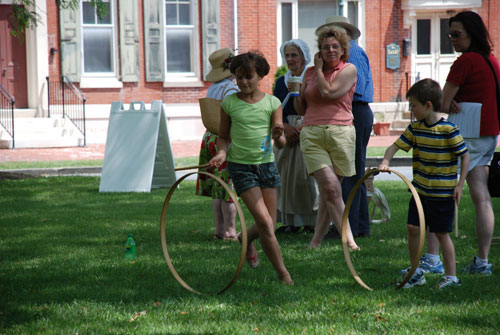The Green: Dover, Delaware

Summary
The Green's one-acre expanse of grass and foliage has witnessed significant Dover events dating back more than 300 years. A clue to The Green's Colonial-era heritage comes from the buildings surrounding the rectangular-shaped park. The Green has witnessed the passions of revolutionaries, the birth of a nation, deep divisions along Union and Confederate lines, and a ghostly burial. Today it is part of Dover's downtown business improvement district and is surrounded by a mix of uses that keeps things going nearly round-the-clock.
Designated Area
Two parcels encircled by Green Street and bisected by South State Street, which are located just south of the central business district and west of the State Capitol complex. The Green is connected to the downtown street grid by Bank Lane to the west.

The Green's one-acre expanse of grass and foliage has been a place for civic engagement and community congregation since its inception in 1717. Photo courtesy of City of Dover Department of Planning and Inspections.
Planning Excellence
Originally "New Court House Green," then "Court House Square," and "Market Square," The Green's various names indicated the dominating community use at the time.
Given its status as one of — if not the most — beloved and oft-used public spaces in Dover, the city's 2008 comprehensive plan recognizes the need for different approaches to preservation and rehabilitation activities involving the park compared with other areas of the historic district.

The Green hosts summer concerts and special events such as Art on the Green, First Night Dover and, shown here, Old Dover Days. Photo courtesy of City of Dover Department of Planning and Inspections.
Defining Characteristics, Features
Historic Preservation
- Part of the 501-acre local Dover Green Historic District established in 1961 and added to National Register of Historic Places in 1977; review required for exterior renovation, additions, demolition, and new construction in district, which currently has 79 buildings
- Majority of buildings surrounding The Green architecturally noteworthy; styles include Colonial Revival, Italianate, Second Empire, Gothic Revival, Federal, Neo-Georgian
- The Old State House (1791) is iconic; the Georgian-styled building's noteworthy architectural details include gilt sunflower ceiling sham and grand, dual stairways that served as portal to state's legislative chambers
- Brick outline on sidewalk in front of Old State House shows where 1776 Declaration of Independence read publicly, sparking celebration and burning of King George's portrait
- Modernization of State House in 1873 added mansard roof and central front tower, hiding original front door and Palladian window; new design attacked by many. Building saved from demolition by Colonial Dames, which persuaded legislature to restore colonial appearance in 1909; $3.5 million building upgrade completed in 2007
- Tax credit and incentive programs for historic preservation available at city, county, state, and federal levels for certified historic properties in Dover. Delaware Preservation Fund, Inc. offers short-term, low-interest loans for rehabilitation projects. Downtown Dover Partnership administers facade grant program.
- The Green has benches and historically appropriate replica gaslight lamps
- Historic markers surrounding The Green designate important events and milestones; one graces site of former Golden Fleece Tavern where Delaware became first state to ratify the U.S. Constitution (December 7, 1787)
- Delaware's Continental Regiment mustered at The Green during the American Revolution; monument in front of Old State House commemorates Delaware's Revolutionary War soldiers
- To rid themselves of a ghost, townspeople dug a grave on The Green in 1745 and held an elaborate funeral for a former chief justice
Commitment to Planning
- Dover, including The Green, laid out in 1717; city and other area that eventually becomes Delaware was part of original land grant by the Duke of York to William Penn
- City completed first comprehensive plan in 1960; zoning ordinance followed in 1961; ordinance created local historic district and established zoning overlay for historic area
- Creation of Historic District Commission in 1993 led to adoption of design standards and guidelines for historic district
- The Green is central to Dover's heritage tourism program; part of First State Heritage Park, a museum without walls offering exhibits, tours, and special programs

Surrounded by a variety of uses — judicial, residential, cultural, recreational, and professional — the Green is also surrounded by abundance of historically significant buildings, some of which are visible here in the background. Photo courtesy of City of Dover Department of Planning and Inspections.
Mix of Uses
- The Green is home to a variety of uses: judicial, residential, cultural, recreational, and professional
- Court first held in area that is now The Green as early as 1680; by 1699 a courthouse was erected and used until 1722 when sold for use as a tavern; a new courthouse was erected on the east side of The Green where courts met until 1874
- Present Neo-Georgian-style courthouse (1875) sits on original site on park's eastern edge; Supreme Court of Delaware meets in charming brick building (1912), separated from the Old State House next door in 1974
- Several historic office buildings, often Italianate, built on The Green in mid 1800s; examples include Kirk Building, Short Memorial Building, Old Farmers Bank Building
- Numerous historic residences of prominent Dover politicians, judges, and business leaders surround The Green; the Ridgely House (1728 Colonial Revival) is city's oldest building
- Site of lawn bowling games in the Colonial era, today The Green is used by neighborhood children for tag, catch, informal games; also hosts summer concerts and special events such as Art on the Green, First Night Dover, Old Dover Days


